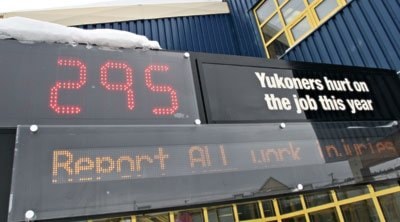Broken bones are expensive.
Cuts and burns cost money.
A spinal cord injury could cost the system more than $1 million in medical bills and lost wages over one year.
The Yukon’s rate of workplace accidents is soaring and, combined with other factors, that means high Workers’ Compensation costs for the territory’s employers.
Today employers are paying an average rate of $2.64 per $100 of payroll.
Some are paying $12.24.
Despite those rates, employer payments are still not covering all of the costs of the Yukon Workers’ Compensation Heath and Safety Board.
“That’s alarming, or that should be alarming,” board president Valerie Royle told a group of employers at a Whitehorse Chamber of Commerce luncheon on Tuesday.
“We still have a major problem in this territory,” said Royle.
In 2006, there were 1,984 reported injuries and three deaths.
As of Wednesday morning there were 295 in 2007 — that’s more than three injuries per day.
That’s 14-per-cent higher than last year at this time.
That number is forefront in the minds of Yukoners this month after Workers’ Compensation erected a scoreboard in front of its Fourth Avenue office late last year.
The Yukon’s “accident rate is way too high, but I don’t know why,” said Inukshuk Planning and Development owner Ian Robertson after the luncheon.
The Whitehorse-based environmental planning firm employs five workers and hasn’t had an accident claim in years, said Robertson.
Many employers are eager to prevent injuries and lower their rates, but they need more transparency and clearer statistics from the board, he said.
“If you want me to take action, tell me why.
“If you don’t give me the information to work with then I don’t know where the problem is.”
Although the number of reported injury rates in the territory is high, Workers’ Compensation cannot determine whether that’s due to workplace carelessness or better reporting of injuries.
The board recently created a new computer system that can sort its statistics into type of injury.
Those numbers were not available on Wednesday morning because the new and old systems had not been synchronized, said spokesperson Mark Hill.
Workers’ Compensation plans to release those statistics in early April.
But it’s not just the statistics that are driving up costs to employers, said Royle.
“People who are off work are staying off work for a long time,” said Royle.
The longer employees are off work, the longer Workers’ Compensation pays out lost wages, which increases costs.
But medical costs on a claim are usually far higher than the wage-loss costs, said Royle.
Assessment dollars pay for all the health-care costs associated with injured workers — every doctor’s visit, every emergency room visit, surgery, physiotherapy, prescription drugs — are all covered under the system.
Medical costs are high in the Yukon, and they’re rising, she added.
The solution is injury prevention.
“As employers, you hold the key.
“You’ve heard it and you’re sick of hearing it, but guess what? The solution is putting health and safety programs in every workplace,” Royle told assembled business leaders and civil servants at the Gold Rush Inn.
“If every employer in the Yukon met the minimum requirements of the occupational health and safety act, I can guarantee you the number on that sign would be lower.”
Workers’ Compensation is offering local employers a tiered incentive program dubbed CHOICES that rewards businesses for running safety programs and back-to-work programs.
Whitehorse Chamber of Commerce president Rick Karp organized the luncheon after hearing complaints from local business owners who are confused about why rates are so high.
“We’ve been getting feedback from our membership asking why the rates are going up and what can be done about it,” said Karp.
“Now it’s time for employers to catch up and become really aware that we must bring safety and prevention into the workplace and stop having these accidents.
“Whitehorse has to stop being the worst place in Canada to work.
Lowering injury rates means changing the way people think about safety.
Take the bicycle helmet for example, he said.
When little kids jump on their bikes today they automatically wear helmets.
But a generation ago they never thought about it.
“It’s that kind of change that we need — that’s the way that we’re going to reduce assessment rates,” said Karp.
